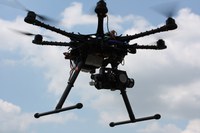
Unmanned Aerial Systems
Within the laboratory, researchers and students are directly involved in all aspects of the UAS development process: modelling, preliminary and detailed design, control system development, hardware/software-in-the-loop simulations, avionics prototyping and flight testing.
The Flight Mechanics Laboratory collaborates with important scientific partners. The most representative example is the INGV-RAVEN project, a fixed-wing UAS that will be instrumented and deployed by INGV (National Institute of Geophysics and Volcanology) for monitoring active volcanoes.
The Flight Mechanics Laboratory is one of the laboratories of the AERONAUTICS SPACE AND MOBILITY CIRI (Interdepartmental Centre for Industrial Research) at the University of Bologna.
Resources
- Remotely Piloted Aircraft Systems (SAPR)
The laboratory is equipped with a fleet of SAPRs (fixed-wing aircraft, helicopters and multi-rotor systems) used for both research and a wide range of applications:
- Design of high-performance multi-rotor systems
- Cooperative flight
- Aerial photography and video filming
- 3D reconstruction
- Thermal analysis
A DC (0..150 V, 1800 W) programmable electronic load used to assess the status of batteries and their performance. This electronic test bench can operate in six different modes and be remotely controlled via a graphical interface.
- Test bench for brushless motors
A test bench specially designed for studying the performance of small and medium brushless motors.
Data from different sensors (air particles and ion counter, gas concentrations, humidity, pressure, temperature, etc.) are collected and georeferenced by means of embedded acquisition systems.
